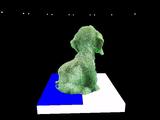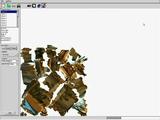Last year, at about this time, I went through an itch to implement various optic-flow algorithms. One that was brought to my attention by a classmate was the grid-powered non-linear registration from the medical community:
Shortly after implementing the method, I was driven to write a GPU optimized version. First, because I wanted to use Cuda. After I got started, I realized it was just as easy to implement the idea using shaders alone. I tested out using gauss-siedel to solve the sparse system of equations on the GPU needed for the diffusion component of the algorithm (they actually use adaptive operator splitting and a fast tri-diagonal solver in the paper, I believe). I remember not being all that impressed by the speedup that I attained (somewhat less than 2 times for this solver including read back, maybe 4 times without reading back). I ended up using an explicit filtering approach for the diffusion.
I wanted to post the code (it has some internal dependencies for creating windows and initing shaders, if anyone is interested I can supply): gpu-gauss-0.0.tar.gz
I didn’t actually compare the timings to the CPU implementation, but here is an example input sequence (same image perspectively warped):
Below is a cross-faded animation of the warped gifs. I didn’t really tweak the parameters (there are a couple for # iterations), but one-way flow took about 0.9 seconds on a geforce 8800 (including loading the images and saving, etc). This was run using the command: ./warp /tmp/w0.png /tmp/w1.png --seq=0 --its=20 --upd_its=20 --glob_its=40. There are a couple of artifacts around the boundary, but for the most part it looks pretty accurate. I have a couple other implementations of optic flow to post sometime.








